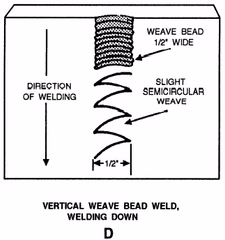Table of Contents
ToggleWhat Is Vertical down Welding?
Welding is a task that requires both technical skill and physical effort. Choosing the right welding position can greatly enhance efficiency, but environmental factors can sometimes significantly impact your decision. When working in more challenging positions, like vertical welding, these factors become even more critical.
In vertical welding, the weld and plate are positioned vertically, and the process can be done in two ways: vertical up, where welding moves from the bottom to the top of the joint, and vertical down, where welding moves from the top to the bottom. This article focuses on the advantages and challenges of the vertical down technique, a method that often presents unique difficulties.
Advantages of Vertical Down Welding
- Increased Deposition Rate
One of the primary advantages of vertical down welding is the increased deposition rate compared to other welding techniques. Since the weld metal flows downward, gravity assists in the fusion process, allowing for faster welding speeds and higher productivity. This can be particularly beneficial when working on large-scale projects that require a significant amount of welding.
- Improved Penetration
Vertical down welding typically provides improved penetration compared to other welding positions. The downward direction of the arc and the gravitational force help direct the heat and weld metal into the joint, resulting in deeper penetration. This is advantageous when welding thicker materials or when a strong and full-penetration weld is required.
- Reduced Heat Input
Vertical down welding often requires lower heat input compared to other positions, such as vertical up or overhead welding. The reduced heat input minimizes the potential for distortion, warping, and heat-affected zone (HAZ) issues. It can also help to control the overall temperature of the workpiece, especially when welding heat-sensitive materials.
- Less Welding Spatter
Vertical down welding generally produces less welding spatter compared to other positions. The downward direction of the arc and weld metal flow helps to minimize spatter and droplet transfer. This results in a cleaner weld with reduced post-weld cleanup, saving time and effort.
- Improved Weld Appearance
When executed properly, vertical down welding can yield aesthetically pleasing welds. The downward direction of the weld metal flow often produces flatter and smoother bead profiles compared to other positions. This can be advantageous in applications where the visual appearance of the weld is important, such as architectural or cosmetic welds.
Challenges of Vertical Down Welding
- Increased Risk of Weld Defects
Vertical down welding presents certain challenges that can increase the risk of weld defects. The fast-paced nature of the process coupled with the gravitational force can make it more difficult to control the weld pool, resulting in potential issues such as lack of fusion, undercutting, and excessive reinforcement. Proper technique, skill, and experience are crucial to minimize these defects.
- Welder Fatigue
Vertical down welding can be physically demanding for welders due to the overhead positioning of the welding torch or electrode holder. Maintaining a steady hand and consistent travel speed over extended periods can lead to welder fatigue. This can impact the quality and consistency of the weld if not properly managed.
- Limited Joint Access
In some cases, vertical down welding can pose challenges in terms of joint access. The downward direction of the weld requires clear access to the joint, which may be hindered by obstructions or limited workspace. This can make it difficult to achieve proper joint preparation, positioning, and travel.
- Potential for Weld Spillage
The downward flow of the weld metal increases the risk of weld spillage, especially when working on vertical or overhead joints. Weld spillage occurs when the molten metal flows beyond the intended weld joint, leading to wasted material and potential rework. Skill and precise control are necessary to prevent weld spillage during vertical down welding.
- Operator Skill and Experience
Vertical down welding demands a higher level of skill and experience compared to other welding positions. Maintaining proper arc length, travel speed, and manipulation techniques while controlling the weld pool requires a deep understanding of the process. Adequate training and practice are essential to master the nuances of vertical down welding.


